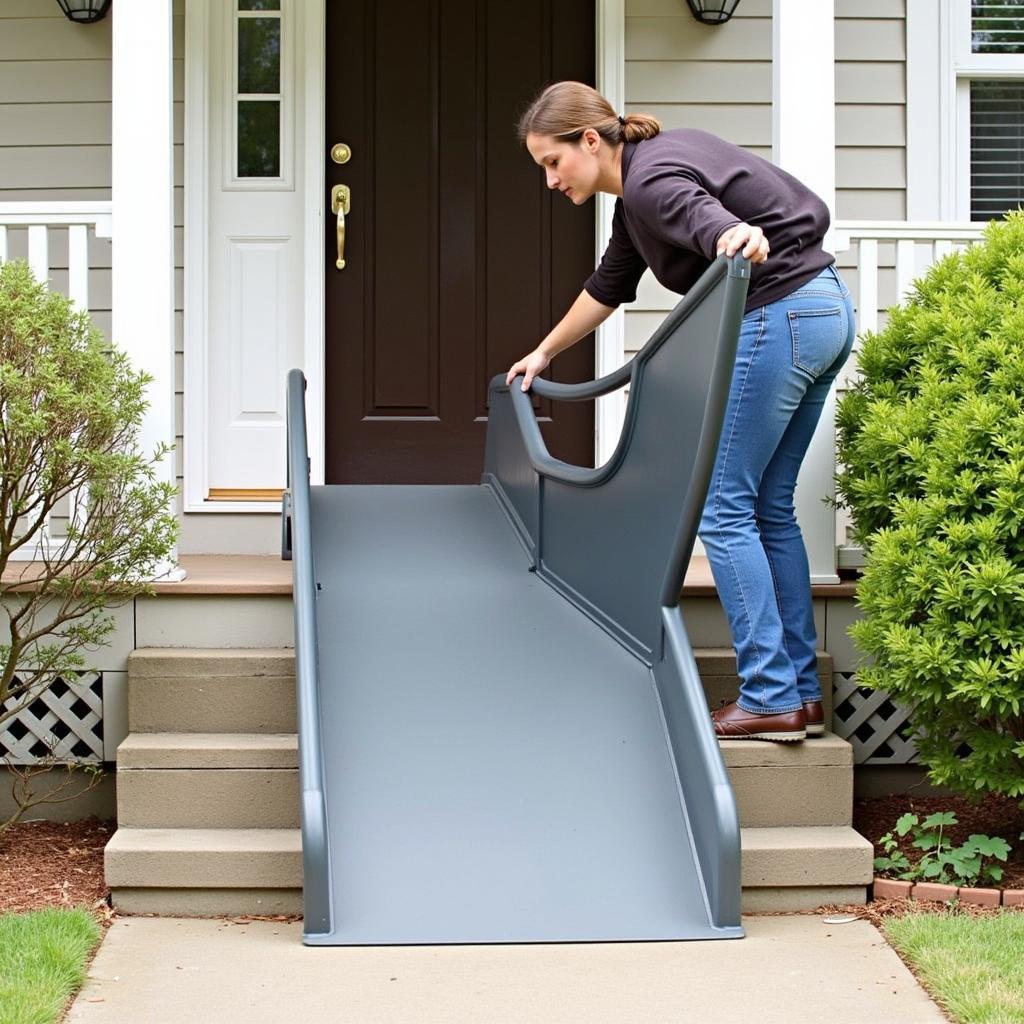Choosing the Right Plastic Ramps for Wheelchairs
Plastic Ramps For Wheelchairs offer a portable and often affordable solution for overcoming small steps and thresholds. Choosing the right ramp depends on several factors, including the height of the step, the weight of the wheelchair user, and the available space. Understanding these variables is crucial for ensuring safety and ease of use.
Factors to Consider When Selecting Plastic Ramps for Wheelchairs
Selecting the appropriate plastic ramp for wheelchairs is crucial for safety and accessibility. Consider these important factors before making a purchase:
Ramp Length and Slope
The length of the ramp directly impacts the steepness, or slope. A longer ramp creates a gentler slope, making it easier to ascend and descend. For example, a 1-inch rise typically requires a ramp length of 12 inches for a safe incline. Longer ramps are generally recommended, especially for powered wheelchairs or users with limited upper body strength. Shorter ramps, while more portable, can be challenging for some users.
Weight Capacity
Plastic ramps have varying weight capacities. It’s essential to choose a ramp that can safely support the combined weight of the wheelchair user and the wheelchair itself. Exceeding the weight capacity can damage the ramp and potentially cause injury. Always check the manufacturer’s specifications for weight limits.
Material and Durability
While all are categorized as “plastic,” ramps can be made from different types of plastic, each with its own durability and weight capacity. High-density polyethylene (HDPE) is a common choice due to its strength and weather resistance. Ensure the ramp material is non-slip and can withstand regular use and exposure to the elements.
 Plastic Wheelchair Ramp Weight Capacity Illustration
Plastic Wheelchair Ramp Weight Capacity Illustration
Portability and Storage
Consider how often the ramp will be moved and where it will be stored when not in use. Folding or telescoping ramps are convenient for transport and storage. Lightweight ramps are easier to handle, but ensure they still meet the required weight capacity.
Features and Accessories
Some plastic ramps have additional features like built-in handles for carrying, high-contrast edges for visibility, and non-slip surfaces for added safety. Consider these features based on individual needs and preferences.
Different Types of Plastic Ramps for Wheelchairs
Plastic ramps come in a variety of styles to meet diverse needs. Here are some common types:
Threshold Ramps
These small, portable ramps are designed for single steps and raised doorways. They are ideal for navigating minor height differences within a home or building.
Portable Ramps
Portable ramps typically fold or telescope for easy transport and storage. They are versatile and can be used for a variety of applications, from accessing vehicles to overcoming larger steps.
Modular Ramps
Modular ramps consist of interlocking sections that can be configured to create custom lengths and configurations. They are a good option for more permanent or semi-permanent access solutions.
Maintaining Your Plastic Wheelchair Ramp
Proper maintenance can extend the life of your plastic ramp and ensure continued safe use.
- Regularly clean the ramp surface to remove dirt, debris, and any slippery substances.
- Inspect the ramp for any cracks, chips, or other signs of damage.
- Store the ramp in a dry location when not in use to prevent warping or deterioration.
Frequently Asked Questions (FAQs)
-
What is the standard slope for a wheelchair ramp? A 1:12 slope is generally recommended, meaning for every inch of rise, there should be 12 inches of ramp length.
-
Can plastic ramps be used outdoors? Yes, many plastic ramps are designed for both indoor and outdoor use. Look for ramps made from weather-resistant materials.
-
How do I choose the right ramp length? Measure the height of the step or obstacle and use the 1:12 slope ratio to determine the required ramp length.
-
Are plastic ramps slippery when wet? Look for ramps with non-slip surfaces or add non-slip tape for added traction.
-
How much weight can a plastic ramp hold? Weight capacity varies depending on the ramp model. Always check the manufacturer’s specifications.
-
Are plastic ramps easy to install? Most plastic ramps require no installation and can be placed directly over the step or obstacle.
-
Where can I buy plastic ramps for wheelchairs? Plastic ramps are available from medical supply stores, online retailers, and home improvement centers.
 Installing a Plastic Wheelchair Ramp
Installing a Plastic Wheelchair Ramp
Conclusion
Choosing the right plastic ramps for wheelchairs requires careful consideration of several factors, from ramp length and weight capacity to portability and features. By understanding these elements, you can select a ramp that provides safe, convenient, and reliable access. Using the correct ramp ensures individuals maintain their independence and mobility. Remember to always prioritize safety and choose a ramp that meets individual needs and circumstances.
More Information and Assistance
For further assistance or inquiries regarding plastic ramps for wheelchairs, please contact us at Phone Number: 0989060241, Email: [email protected], or visit us at Address: Tở 2, ấp 5, An Khương, Hớn Quản, Bình Phước, Việt Nam. Our customer service team is available 24/7 to help you find the perfect ramp for your needs. You can also explore other related articles on our website for more detailed information about accessibility solutions.

